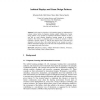ICALT
2007
IEEE
13 years 11 months ago
2007
IEEE
Cognitive trait model (CTM) is a student model that aims to create profiles of learners’ cognitive traits. Divergent associative learning (DAL) denotes the characteristic of lea...
ECTEL
2010
Springer
13 years 11 months ago
2010
Springer
In this paper, we investigate the components of a Research 2.0 infrastructure. We propose building blocks and their concrete implementation to leverage Research 2.0 practice and te...
ECTEL
2010
Springer
13 years 11 months ago
2010
Springer
As Technology Enhanced Learning (TEL) systems become more essential to education there is an increasing need for their creators to reduce risk and to design for success. We argue t...
ECTEL
2010
Springer
13 years 11 months ago
2010
Springer
In this paper we describe a social learning game we implemented to evaluate various means of ubiquitous learning support. Making use of game design patterns it was possible to impl...
ICALT
2010
IEEE
13 years 11 months ago
2010
IEEE
— This paper summarises the analyses of participant interaction within the Twitter microblogging environment. The study employs longitudinal probabilistic social network analysis...
ICALT
2010
IEEE
13 years 11 months ago
2010
IEEE
—Adaptive educational hypermedia allows lessons to be personalized according to the needs of the learner. However, to achieve this, content must be split into stand-alone fragmen...
ICALT
2010
IEEE
13 years 11 months ago
2010
IEEE
— Most e-learning systems require intervention from a teacher. The development of adaptive hypermedia systems, such as intelligent tutoring systems, aimed to reduce the teachers�...
SIGCOMM
2010
ACM
13 years 11 months ago
2010
ACM
As smartphones evolve researchers are studying new techniques to ease the human-mobile interaction. We propose EyePhone, a novel "hand-free" interfacing system capable o...
ICML
2010
IEEE
13 years 11 months ago
2010
IEEE
We present an overview of FAB-MAP, an algorithm for place recognition and mapping developed for infrastructure-free mobile robot navigation in large environments. The system allow...
ICML
2010
IEEE
13 years 11 months ago
2010
IEEE
We present and evaluate a machine learning approach to constructing patient-specific classifiers that detect the onset of an epileptic seizure through analysis of the scalp EEG, a...

